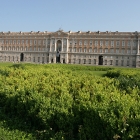Caserta, the Italian Versailles with bigger gardens
The king of Naples, Carlos Sebastian (Charles VII), wanted to underline his status as a descendant of Louis XIV (The Sun King) and ordered a palace that would compete with the famous French castle of Versailles. For this Charles VII picked a rural area 20 km away from Naples. The existing Royal Palace in Naples was considered dangerously close to the shore, in a time when ships came equipped with assault canons. Away from the sea and from Vesuvius, in the tranquil village of Caserta, the Bourbon king and his architect of Dutch origin Ludwig van Wittel (Luigi Vanvitelli), modified the landscape for a palace with a garden 3,2 km long, that ends with a mountain from which a river flows directly towards the palace. The irony is the Charles VII gave up the throne of Naples to become king of Spain before he could move to Caserta. Nor did his architect, Luigi Vanvitelli, live to see the project finished.
In order to complete the ambitious project an entire village was moved and hundreds of workers, including detainees and former pirates, took a tremendous effort. The style of the palace is Baroque, with a classical austere exterior and highly decorated interiors. The palace has over 1200 rooms, a number that speaks about the opulence of the Bourbon monarchs. Some of the decorations might be considered outdated for today’s taste, but some still impress today. The great marble stair made from one stone block, with sculpted lions and the throne room remind the Royal destination of this place. Some famous Hollywood films (Star Wars and Mission Impossible) used the palace and especially the stairway in order to mimic the Vatican.
The garden is even more interesting. It was designed by Carlo Vanvitelli and John Graefer. It is 3,2 km long, which makes it rather boring, in the absence of flower arrangements or swans. A huge basin of water is packed with fish of considerable size. The five fountains are works of art with fantastic animals and deities that remind the public fountains in Rome. An impressive cascade flows into the English garden from the other end of the domain, where an aqueduct was built to bring the needed water.
Mai multe despre: Architecture, Italia • Architecture • baroque architecture • Bourbon Dinasty • Caserta • Caserta Palace • Italia • Italy • John Garefer • Luigi Vanvitelli • Naples • palace • Versailles- Home Page
start page - Architecture
landmark buildings - Sacred architecture
places of worship - Nature
landscape photography - Concert
performing artists - Christmas
Santa Claus pictures
- Jooble
jobs for photographers - Escape
an out of control blog - Merry Christmas
The best organizer of Christmas parties - Astro photo
Eclipse hunting and astrological photography



